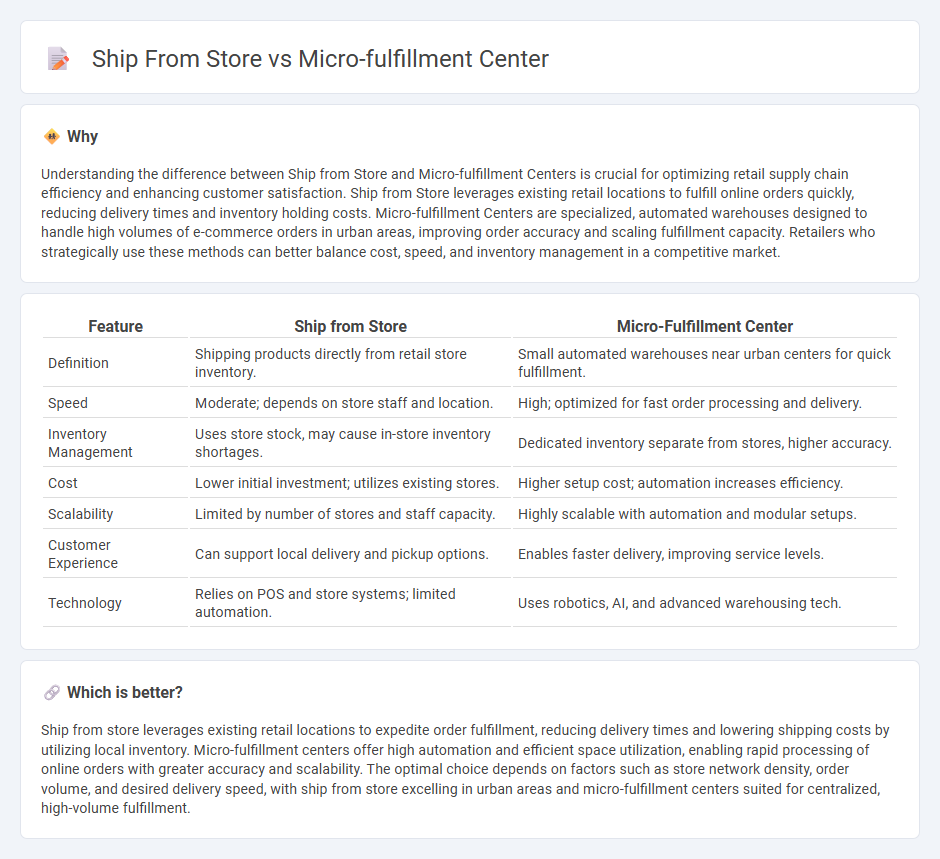
Ship from store leverages existing retail locations to fulfill online orders quickly by using in-store inventory, reducing last-mile delivery times and transportation costs. Micro-fulfillment centers are compact, automated warehouses situated near urban areas that optimize inventory management and speed up order processing for e-commerce fulfillment. Explore the benefits and challenges of each strategy to determine the best approach for your retail operations.
Why it is important
Understanding the difference between Ship from Store and Micro-fulfillment Centers is crucial for optimizing retail supply chain efficiency and enhancing customer satisfaction. Ship from Store leverages existing retail locations to fulfill online orders quickly, reducing delivery times and inventory holding costs. Micro-fulfillment Centers are specialized, automated warehouses designed to handle high volumes of e-commerce orders in urban areas, improving order accuracy and scaling fulfillment capacity. Retailers who strategically use these methods can better balance cost, speed, and inventory management in a competitive market.
Comparison Table
| Feature | Ship from Store | Micro-Fulfillment Center |
|---|---|---|
| Definition | Shipping products directly from retail store inventory. | Small automated warehouses near urban centers for quick fulfillment. |
| Speed | Moderate; depends on store staff and location. | High; optimized for fast order processing and delivery. |
| Inventory Management | Uses store stock, may cause in-store inventory shortages. | Dedicated inventory separate from stores, higher accuracy. |
| Cost | Lower initial investment; utilizes existing stores. | Higher setup cost; automation increases efficiency. |
| Scalability | Limited by number of stores and staff capacity. | Highly scalable with automation and modular setups. |
| Customer Experience | Can support local delivery and pickup options. | Enables faster delivery, improving service levels. |
| Technology | Relies on POS and store systems; limited automation. | Uses robotics, AI, and advanced warehousing tech. |
Which is better?
Ship from store leverages existing retail locations to expedite order fulfillment, reducing delivery times and lowering shipping costs by utilizing local inventory. Micro-fulfillment centers offer high automation and efficient space utilization, enabling rapid processing of online orders with greater accuracy and scalability. The optimal choice depends on factors such as store network density, order volume, and desired delivery speed, with ship from store excelling in urban areas and micro-fulfillment centers suited for centralized, high-volume fulfillment.
Connection
Ship from store leverages retail locations as mini distribution hubs, reducing delivery times by fulfilling online orders directly from local stores. Micro-fulfillment centers integrate automated systems within or near stores, increasing inventory accuracy and order processing speed for ship-from-store operations. Together, they optimize inventory utilization and enhance customer delivery experiences in omnichannel retail strategies.
Key Terms
Inventory Management
Micro-fulfillment centers optimize inventory management by centralizing stock in automated, small-scale warehouses near urban areas, enabling faster order processing and reduced replenishment cycles. Ship from store leverages existing retail inventory, dynamically reallocating stock to fulfill online orders directly from physical stores, improving stock visibility but potentially depleting in-store product availability. Discover how these inventory strategies impact operational efficiency and customer satisfaction.
Order Fulfillment Speed
Micro-fulfillment centers significantly enhance order fulfillment speed by utilizing automated systems and proximity to urban areas, reducing handling and transit times. Ship from store leverages existing retail locations but often faces longer processing times due to manual picking and in-store inventory constraints. Discover more about how these strategies impact customer satisfaction and operational efficiency.
Last-Mile Delivery
Micro-fulfillment centers enable rapid last-mile delivery by strategically placing automated warehouses near urban areas, reducing delivery times and costs. Ship from store leverages existing retail locations to fulfill orders, enhancing inventory utilization and offering faster local deliveries. Explore how these strategies revolutionize last-mile fulfillment for improved customer satisfaction.
Source and External Links
What Are Micro Fulfillment Centers? - City National Bank - Micro-fulfillment centers (MFCs) are small warehouses, typically 3,000 to 10,000 square feet, designed to hold fast-moving products for rapid shipping and feature highly compact layouts enabling more products per square foot than conventional warehouses.
Micro fulfillment center: How it helps retailers speed up fulfillment - MFCs are strategically located small-scale storage and fulfillment facilities near consumers, often in urban areas or within existing retail stores, enabling faster order fulfillment with advanced automation technologies.
Micro-Fulfillment: The Next Step to Faster, More Efficient Last-Mile ... - By locating small-scale warehouses closer to consumers, micro-fulfillment centers significantly reduce last-mile delivery costs and times, offering a cost-effective and efficient solution for urban and regional distribution.
 dowidth.com
dowidth.com